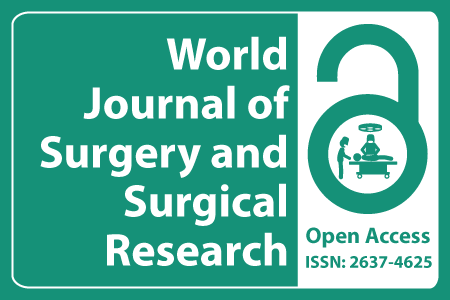
Journal Basic Info
- Impact Factor: 1.989**
- H-Index: 6
- ISSN: 2637-4625
- DOI: 10.25107/2637-4625
Major Scope
- Obstetrics & Gynecology
- Spine Surgery
- Neurological Surgery
- Plastic Surgery
- Bariatric Surgery
- Ophthalmology
- Otolaryngology & ENT Surgery
- Surgery & Surgical Research
Abstract
Citation: World J Surg Surg Res. 2019;2(1):1160.DOI: 10.25107/2637-4625.1160
Management of Splenic Artery Aneurysm during Labor
Meghan E Wandtke, Samer Alharthi, Albert Tsang and Joseph Sferra
Department of General Surgery, University of Toledo, USA
*Correspondance to: Meghan E Wandtke
PDF Full Text Case Report | Open Access
Abstract:
Introduction: The prevalence of Splenic Artery Aneurysms is reported to be between 0.01% and 10.4%; these visceral aneurysms are often discovered incidentally on imaging or when they rupture. Rupture of a splenic artery aneurysm is associated with a 2% mortality, which increases to 75% among pregnant women with a fetal mortality of 95%. Case Presentation: A 29-year-old G4P3003 pregnant female, 33 + 4/7 weeks, presented with pain in the epigastrium and left upper quadrant. The pain had been present for three to four months, but became progressively worse over the few days prior to presentation to the emergency department. CT angiogram and ultrasound revealed splenic artery aneurysms measuring 2.3 cm and 1.9 cm. On admission, a multidisciplinary approach was taken and OB/GYN and general surgery were involved early in the care of this patient. On the day she was scheduled for IR embolization, fetal decelerations were noted on fetal monitoring which became more regular and prolonged and the patient began feeling regular contractions. Her cervix started to dilate, and she progressed into labor. There was fear she had high risk of rupture with Valsalva so the patient underwent cesarean section with the general surgeon in the room who proceeded with laparoscopic splenectomy once the abdomen was assessed for signs intra-peritoneal hemorrhage. The newborn had good APGARs and both mother and the newborn survived. Conclusion: Splenic artery aneurysms are rare, and if they rupture, they are associated with a high maternal and fetal mortality rate. When a patient is diagnosed, action is necessary to ensure optimal maternal and fetal outcomes. In this case, we performed a laparoscopic splenectomy after cesarean section with great outcomes.
Keywords:
Cite the Article:
Wandtke ME, Alharthi S, Tsang A, Sferra J. Management of Splenic Artery Aneurysm during Labor. World J Surg Surgical Res. 2019; 2: 1160..













